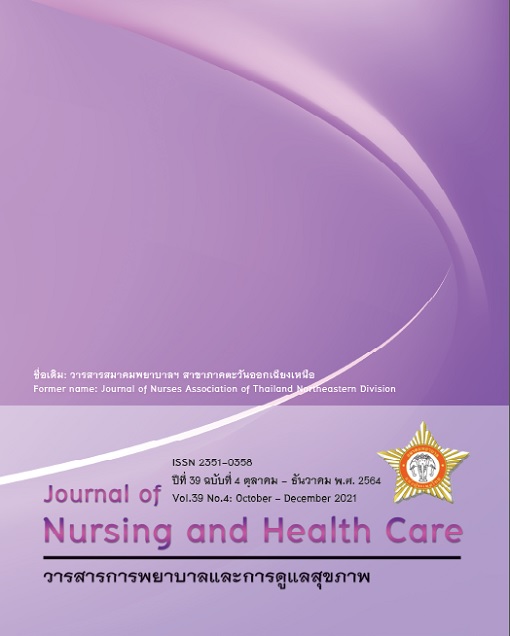การพัฒนาแบบประเมินความเสี่ยงของการเกิดภาวะแทรกซ้อนระบบทางเดินหายใจหลังได้รับ การระงับความรู้สึกแบบทั่วร่างกาย
คำสำคัญ:
แบบประเมิน, ภาวะแทรกซ้อน, การระงับความรู้สึกแบบทั่วร่างกาย, ระบบทางเดินหายใจ, ปัจจัยเสี่ยงบทคัดย่อ
การวิจัยและพัฒนานี้มีวัตถุประสงค์เพื่อพัฒนาแบบประเมินความเสี่ยงของการเกิดภาวะแทรกซ้อนระบบทางเดินหายใจหลังได้รับการระงับความรู้สึกแบบทั่วร่างกาย (post-general anesthesia respiratory complications: P-GARCs) ดำเนินการศึกษาในผู้ป่วยจำนวน 322 ราย เลือกตัวอย่างแบบเจาะจงตามคุณสมบัติ แบ่งการศึกษาเป็น 3 ระยะ คือ 1) ระยะพัฒนาแบบประเมิน 2) ระยะทดสอบประสิทธิภาพและ 3) ระยะนำไปปฏิบัติจริง วิเคราะห์ข้อมูลทั่วไปโดยใช้สถิติเชิงพรรณนา วิเคราะห์ปัจจัยเสี่ยง P-GARCs โดยใช้สถิติ Cox proportional hazards regression และประเมินประสิทธิภาพในการวินิจฉัยของแบบประเมินโดยใช้ receiver operating characteristic (ROC) curve
ผลการศึกษา พบว่า แบบประเมินความเสี่ยงของการเกิด P-GARCs (P-GARCs risk assessment form: PRAF) มี 11 ข้อ รวม 30 คะแนน ประเมินความเสี่ยงการเกิด P-GARCs 2 ด้าน คือ 1) ด้านผู้ป่วย ได้แก่ อายุ เพศ สถานะสุขภาพทางวิสัญญี ดัชนีมวลกาย โรคระบบหายใจ ระดับออกซิเจนในเลือด และการสูบบุหรี่ และ 2) ด้านการดูแลรักษา ได้แก่ ตำแหน่งและประเภทของการผ่าตัด ระยะเวลาใส่ท่อช่วยหายใจ และจำนวนครั้งที่ใส่ท่อช่วยหายใจ PRAF มีค่าดัชนีความตรงเชิงเนื้อหา = 0.87 และ inter-rater reliability = 0.81 เมื่อใช้ PRAF ประเมินความเสี่ยง P-GARCs พบว่าที่จุด cut-off 13 คะแนน PRAF มี sensitivity 96.9% specificity 85.2% และ Area under Curve = 0.73 (95%CI 0.64-0.82, p < .001) ซึ่งสะท้อนว่า PRAF มีประสิทธิภาพในการประเมินความเสี่ยง P-GARCs และสามารถใช้คัดกรองผู้ป่วยเพื่อวางแผนป้องกันภาวะแทรกซ้อนดังกล่าวต่อไป
Downloads
เอกสารอ้างอิง
2. Patel K, Hadian F, Ali A, Broadley G, Evans K., Horder C, et al. Postoperative pulmonary complications following major elective abdominal surgery: A cohort study; Perioperative Medicine. 2016;5(10): 2-7.
3. Charuluxananan S, et al. Multicentered study of anesthesia: related mortality and adverse events by incident reports in Thailand. Nonthaburi: Health Systems Research Institute; 2018. (in Thai).
4. Gottschalk A., Aken HV, Zenz M, Standl T. Is anesthesia dangerous. Deutsches Aerzteblatt Online. 2011;108(27):469–75.
5. Divatia JV. Safe anesthesia for all Indians: a distant dream. Indian J Anaesth. 2017;61(7):531-3.
6. Xará D, Santos A, Abelha F. Adverse respiratory events in a post-anesthesia care unit. Arch Bronconeumol. 2015;51(2):69–75.
7. Nafiu OO, Ramachandran SK, Ackwerh R, Tremper KK., Campbell DA, Stanley JC. Factors associated with and consequences of unplanned post-operative intubation in elderly vascular and general surgery patients. Eur J Anaesthesiol. 2011;28(3):220–4.
8. Khan NA, Quan H, Bugar JM, Lemaire JB, Brant R, Ghali WA. Association of postoperative complications with hospital costs and length of stay in a tertiary care center. J Gen Intern Med. 2006;21(2):177–80.
9. Anesthesia Group, Phu Khiao Chaloem Phra Kiat Hospital. Annual report 2019. Chaiyaphum: Anesthesia Group, Phu Khiao Chaloem Phra Kiat Hospital; 2019. (in Thai).
10. Russotto V, Myatra SN, Laffey JG. What’s new in airway management of the critically ill. Intensive Care Med. 2019;45(11):1615–8.
11. Jeong BH, Shin B, Eom JS, Yoo H, Song W, Han S, et al. Development of a prediction rule for estimating postoperative pulmonary complications. PloS One. 2014;9(12): e113656.
12. Fernandez-Bustamante A, Frendl G, Sprung J, Kor DJ, Subramaniam B, Ruiz RM, Lee J, et al. Postoperative Pulmonary Complications, Early Mortality, and Hospital Stay Following Noncardiothoracic Surgery. JAMA Surg. 2017;152(2):157-66.
13. Buckwalter KC, Cullen L, Hanrahan K, Kleiber C, McCarthy AM, et al. Iowa Model of Evidence-Based practice: Revisions and validation. Worldviews on Evidence-Based Nursing. 2017;14(3):175–82.
14. Bernard R. Fundamentals of biostatistics. (5th ed.). Duxbury: Thomson learning;2000.
15. Sarakarn P, Munpolsri P. Optimal cut-off points for receiver operating characteristic (ROC) curve analysis in developing tools of health innovations: example using SATATA. Thai Bull Pharm Sci. 2021;16(1). 93-108. (in Thai).
16. Nawarat J, Daraman M, Suttara W, Jitsawang J, Mee-Ngern O. Gait speed cut-off point as a predictor of fear of falling in older adult. Thaksin University Journal. 2018;21(3): 317-24. (in Thai).
17. Trifonova O, Lokhov P, Archakov AI. Metabolic profiling of human blood. Biomeditsinskaya Khimiya. 2014;60. 281-94. 10.18097/pbmc20146003281.
18. Canet J, Gallart L, Gomar C, Paluzie G, Vallès J, Castillo J, et al. J; ARISCAT Group. Prediction of postoperative pulmonary complications in a population-based surgical cohort. Anesthesiology. 2010 Dec;113(6):1338-50.
19. Miskovic A, Lumb AB. Postoperative pulmonary complications. Br J Anaesth. 2017;118(3):317-34.



